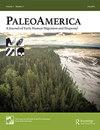Some Opinions about Monte Verde: Response to Dillehay (2019) and Dillehay, Pino, and Ocampo (2020)
IF 1.7
Q1 ANTHROPOLOGY
引用次数: 5
Abstract
ABSTRACT This article is a response to Dillehay [2019. “Un ensayo sobre genética, arqueología y movilidad humana temprana.” Mundo de Antes 13 (2): 13–65] and Dillehay, Pino, and Ocampo [2020. “Comments on Archaeological Remains at the Monte Verde Site Complex, Chile.” PaleoAmerica. https://doi.org/10.1080/20555563.2020.1762399], who criticized our comments about Monte Verde-I and Chinchihuapi-I as well as our suggestion of the tightening of the age of Monte Verde-II [Politis, G. G., and L. Prates. 2018. “Clocking the Arrival of Homo sapiens in the Southern Cone of South America.” In New Perspectives on the Peopling of the Americas, edited by K. Harvati, G. Jäger, and H. Reyes Centeno, 79–106. Tübingen: Kerns Verlag]. They claimed that we purposefully ignored pertinent data to support our opinions, and that we made several mistakes when analyzing the evidence. In this article we demonstrate that we did not ignore any relevant data, and that the putative errors are in fact alternative interpretations based on the available data and recent studies about site formation processes.关于佛得角的一些看法:对Dillehay(2019)和Dillehai,Pino和Ocampo(2020)的回应
本文是对Dillehay[2019]的回应。“unensayo sobre gensamtica, arqueología y movilidad humana temprana。”[2]张晓明,张晓明,张晓明,等。中国农业科学[j] .中国农业科学,2013(2):13 - 65。“对智利蒙特佛得角遗址建筑群考古遗迹的评论”。PaleoAmerica。https://doi.org/10.1080/20555563.2020.1762399],他们批评了我们对Monte Verde-I和chinchihuapi的评论,以及我们建议收紧Monte Verde-II的年龄[Politis, G. G. and L. Prates. 2018]。“记录智人到达南美洲南锥体的时间。”《美洲人的新视角》,K. harati, G. Jäger和H. Reyes Centeno编辑,第79-106页。tbingen: Kerns Verlag。他们声称我们故意忽略相关数据来支持我们的观点,并且我们在分析证据时犯了几个错误。在这篇文章中,我们证明了我们没有忽略任何相关数据,并且假设的错误实际上是基于现有数据和最近关于遗址形成过程的研究的替代解释。
本文章由计算机程序翻译,如有差异,请以英文原文为准。
求助全文
约1分钟内获得全文
求助全文
来源期刊

PaleoAmerica
Earth and Planetary Sciences-Paleontology
CiteScore
3.70
自引率
0.00%
发文量
15
期刊介绍:
PaleoAmerica disseminates new research results and ideas about early human dispersal and migrations, with a particular focus on the Americas. It fosters an interdisciplinary dialog between archaeologists, geneticists and other scientists investigating the dispersal of modern humans during the late Pleistocene. The journal has three goals: First and foremost, the journal is a vehicle for the presentation of new research results. Second, it includes editorials on special topics written by leaders in the field. Third, the journal solicits essays covering current debates in the field, the state of research in relevant disciplines, and summaries of new research findings in a particular region, for example Beringia, the Eastern Seaboard or the Southern Cone of South America. Although the journal’s focus is the peopling of the Americas, editorials and research essays also highlight the investigation of early human colonization of empty lands in other areas of the world. As techniques are developing so rapidly, work in other regions can be very relevant to the Americas, so the journal will publish research relating to other regions which has relevance to research on the Americas.
 求助内容:
求助内容: 应助结果提醒方式:
应助结果提醒方式:


